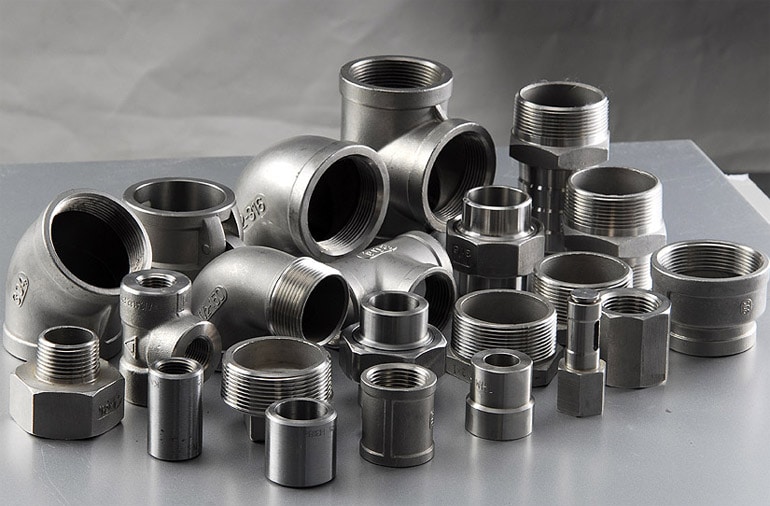
In the vast network of industrial piping systems that crisscross our world, transporting everything from water and chemicals to gases and oil, the integrity of each component is paramount. A single leak or failure can have catastrophic consequences, leading to downtime, environmental damage, and even safety hazards. This is where the robust and reliable stainless steel 304L pipe fittings step in, playing a crucial role in ensuring the safe and efficient operation of countless industrial processes.
Stainless steel 304L, a low-carbon version of the widely used 304 stainless steel, is renowned for its excellent corrosion resistance, weldability, and formability. These properties make it an ideal material for pipe fittings used in a variety of demanding applications, particularly those involving corrosive environments or requiring hygienic conditions. Pipe fittings made from this alloy offer a robust and long-lasting solution for connecting pipes, changing direction, or adapting to different sizes.
Understanding Stainless Steel 304L Pipe Fittings
Stainless steel 304L pipe fittings are components designed to connect, redirect, or terminate piping systems. They come in a wide array of shapes and sizes, including elbows, tees, reducers, caps, unions, and more. The “304L” designation refers to a specific grade of stainless steel defined by its chemical composition. The lower carbon content in 304L compared to 304 makes it less susceptible to carbide precipitation during welding, which can lead to corrosion in the heat-affected zone.
The key advantage of using 304L stainless steel for pipe fittings lies in its exceptional corrosion resistance. This alloy forms a passive chromium oxide layer on its surface, which protects it from oxidation and other forms of corrosion. This makes 304L fittings ideal for use in harsh environments, including those involving exposure to acids, alkalis, and chlorides.
Applications Across Industries
The versatility and reliability of stainless steel 304L pipe fittings make them indispensable in a wide range of industries:
- Food and Beverage: The hygienic properties of 304L make it a popular choice in the food and beverage industry, where cleanliness and preventing contamination are critical.
- Pharmaceuticals: Similar to the food and beverage industry, pharmaceutical manufacturing requires high levels of hygiene, making 304L fittings ideal for transporting liquids and gases.
- Chemical Processing: Chemical plants utilize 304L fittings to handle a variety of corrosive chemicals, ensuring the safe and efficient transfer of materials.
- Water Treatment: Water treatment facilities often use 304L fittings due to their resistance to corrosion from chlorine and other chemicals used in water purification.
- Oil and Gas: While often not the first choice due to cost, certain applications within oil and gas, especially downstream processing where corrosion is a concern, may utilize 304L.
- Marine: The excellent corrosion resistance of 304L, especially against saltwater, makes it suitable for marine applications, though other stainless grades may be more common.
Advantages of Using Stainless Steel 304L Pipe Fittings
Choosing 304L stainless steel pipe fittings offers several significant advantages:
- Excellent Corrosion Resistance: 304L’s resistance to a wide range of corrosive substances ensures long-lasting performance in harsh environments.
- Hygienic Properties: The smooth surface of stainless steel and its resistance to bacterial growth make it ideal for applications requiring high levels of cleanliness.
- Weldability: 304L exhibits excellent weldability, making it easy to fabricate and install.
- Formability: This alloy is readily formed into various shapes and sizes, allowing for the production of a wide range of fittings.
- Durability: Stainless steel fittings are known for their strength and durability, ensuring long service life.
- Low Maintenance: The corrosion resistance of 304L minimizes the need for maintenance, reducing downtime and costs.
Considerations for Selection and Installation
When selecting and installing stainless steel 304L pipe fittings, several factors need to be considered:
- Operating Temperature and Pressure: The fittings must be selected based on the specific temperature and pressure requirements of the application.
- Fluid Compatibility: The material should be compatible with the fluid being transported to prevent corrosion or other adverse reactions.
- Code Compliance: The fittings should comply with relevant industry standards and codes.
- Welding Procedures: If welding is required, proper welding procedures must be followed to maintain the corrosion resistance of the 304L stainless steel.
- Gasket Material: The gasket material used in conjunction with the fittings must also be compatible with the fluid and operating conditions.
Conclusion
In conclusion, stainless steel 304L pipe fittings are essential components in a wide variety of industrial piping systems. Their exceptional corrosion resistance, hygienic properties, weldability, and formability make them the preferred choice for applications requiring high levels of cleanliness, durability, and reliability. By carefully considering the operating conditions and following proper installation procedures, engineers and designers can leverage the benefits of 304L fittings to create safe, efficient, and long-lasting piping systems. From pharmaceutical plants to food processing facilities, these fittings play a crucial role in ensuring the smooth and reliable transport of fluids that are essential to modern life.





Leave a Reply